The terms quality improvement, patient safety and practice culture are increasingly being used in the context of veterinary care. But what are they? Although these subjects do not form a major part of college or university curriculums they are nevertheless highly relevant to the care that patients receive — learning more about them can improve our ability to treat pets effectively. We will start by discussing ‘practice culture.’
A common definition of culture is ’the way things are done around here’ (Braithwaite et al, 2017). In veterinary practice, culture describes a group of attitudes, beliefs and behaviours that team members share (Braithwaite et al, 2017). This might be a rule that everyone adheres to — perhaps, following a surgical safety checklist — or more subtle cues about what is or is not acceptable (Mannion and Davies, 2018). So, it covers a broad range of things from the obvious to the opaque. Another way of thinking about culture is to consider the attitudes, beliefs and behaviours we are likely to find in a positive culture:
- Team members act with civility toward one another
- The team actively supports trainees and their learning
- A team ethos that emphasises togetherness and unity
- A blame free attitude to errors, accidents, and ‘bad news’
- A positive approach to care that emphasises continual improvement and learning (Shale, 2019).
To simplify this list, two words are often used to illustrate a healthy team culture: compassion and inclusivity (The King's Fund, n.d.). These team attributes help forge closer bonds, which in turn support patients, clients, and the practice. Meanwhile, the opposite of a healthy practice culture would be one in which team members feel inhibited from speaking up about what they see, or reporting accidents of care, and perhaps a workplace in which rudeness is accepted. Unfortunately, quite apart from the fact that incivility makes going to work an unpleasant experience, research also suggests that it has a direct impact on care quality (Riskin et al, 2015; Katz et al, 2019).
So, what are practice cultures like in the veterinary profession? This is a difficult question to answer, and only limited evidence exists at this time. Research investigating so-called veterinary patient safety culture does however suggest that blame is still common, and that communication is based on notions of rank and hierarchy in some settings (Turner, 2017). An effective way of reversing these trends is to explicitly place the goal of quality improvement at the heart of our work. In many ways quality improvement helps prevent a bad culture taking root, and supports togetherness and learning for better standards, but how exactly?
Quality improvement
Figure 1 shows the relationship between quality improvement and practice culture. Quality improvement can be defined as the combined efforts of the whole team to make changes that will lead to better patient outcomes, better system performance (care) and better professional development (learning) (Batalden and Davidoff, 2007). It is a systematic approach to practice performance, by investigating how we are doing now, and how we might do better in the future. It involves the use of auditing tools to identify areas for improvement, and to test changes, and team-based behaviours that improve the flow of communication around the clinic and learning more generally (The Health Foundation, 2021). As illustrated in Figure 2, quality healthcare should be safe, timely, effective, efficient, animal welfare focused, client-values focused, and veterinary-team focused, and quality improvement is the means to accomplish these goals (Rooke et al, 2021). To use an analogy, if the whole practice is a thoroughbred racehorse, quality improvement is a carefully managed diet and exercise regimen to keep it at peak performance (Turner, 2017).
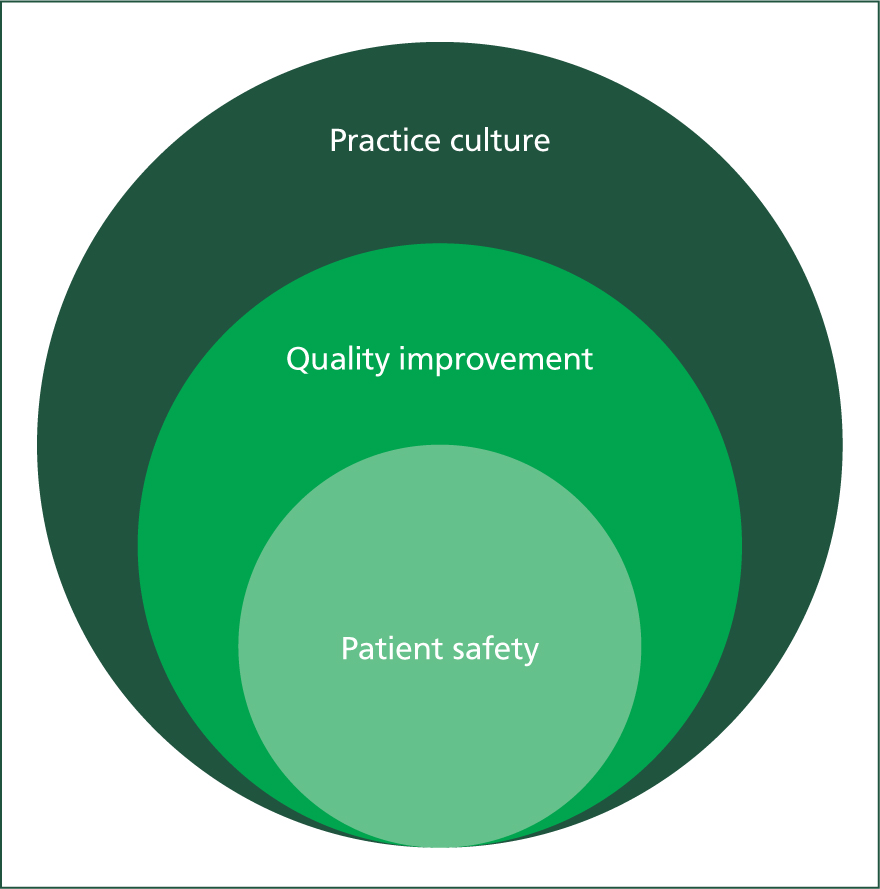
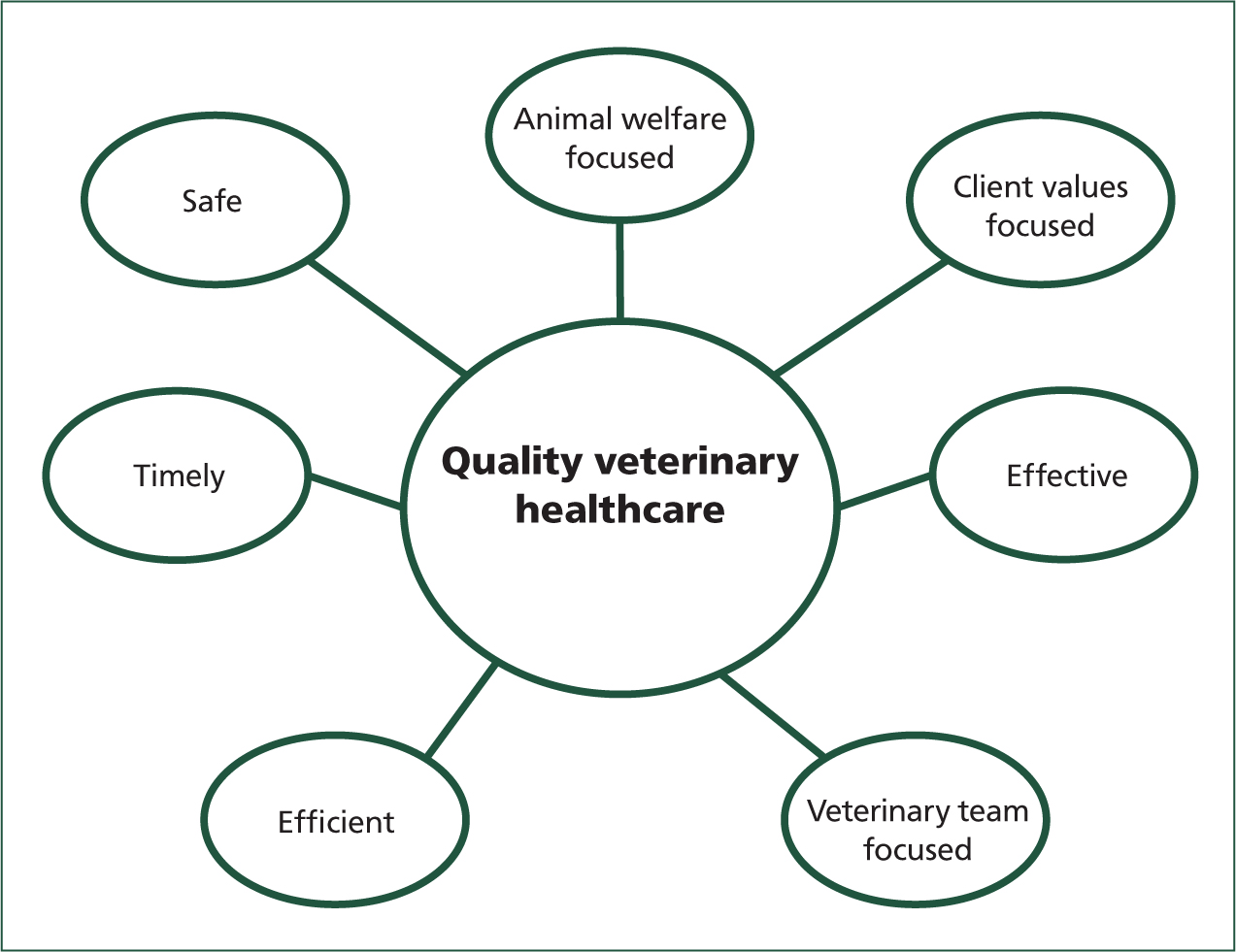
Methods such as clinical audits and significant event audits, and tools such as guidelines, checklists and systems of work, can help veterinary practices to make a start with quality improvement (RCVS Knowledge, n.d.a). RCVS Knowledge has extensive resources for busy veterinary teams to use, including continuing professional development (CPD) courses, templates to download, walk-throughs and real-life case examples (RCVS Knowledge, n.d.b).
Engaging with these quality improvement tools can help improve patient safety and practice culture to benefit all team members.
Clinical audit
Clinical audit is an effective way of progressively improving standards and quality at work (Viner, 2009). Teams that look at evidence and involve team members in drawing up guidelines, can use these along with clinical expertise and the needs of the particular patient and client, to make well-informed decisions. This problem-orientated and team-based approach to clinical situations, can contribute to a healthy practice culture too (Viner, 2009).
Clinical audit is a quality improvement process with the aim of improving outcomes for patients by looking at processes within the practice. It requires an environment in which problems with care or procedural outcomes can be freely discussed. It is therefore important to have a blame free, ‘what is right, not who is right’ culture to allow open and honest discussion with a focus on improvement (Viner, 2009).
It is also necessary to have a culture that is open to learning and making changes, testing those changes and either adopting them, adapting them or abandoning them.
If clinical audit is to be used properly — listening to the team involved in the work, making changes and measuring again — it can be a valuable addition to quality improvement, revealing issues before they cause an error. It can also contribute to improving practice culture by having an open environment where everyone is listened to and change is embraced (Barach and Small, 2000).
Patient safety
In our professional lives we use powerful drugs and perform potentially dangerous procedures in order to help patients, so any mistake can have serious consequences. Patient safety is a discipline that uses the most up-to-date research about human error, and accident prevention to minimise the frequency of adverse events in veterinary care (Oxtoby, 2014). It is also about working together when mishaps do occur (Box 1). Patient safety is defined as: ‘The absence of preventable harm to a patient and reduction of risk of unnecessary harm associated with healthcare to an acceptable minimum. It relies on an understanding that all staff, while committed to helping patients at all times, are nevertheless human and capable of making unintentional mistakes. Patient safety is therefore focused on identifying safety incidents and learning, such that the same error is not made again by a different operative’ (Rooke et al, 2021: 9).
Box 1.Patient safety culture in actionCulture A“Oh no,” Julie looks away from the chart sellotaped to the prep-room cupboard door, her heart is racing she is scared.“What?” Alya asks.Julie looks pale as she leans against the work unit. “Oh no – You are going to be mad with me - I think … I think I've just over-dosed Fennel, the cat spay.”“What! I told you to be careful with drug doses.” The head nurse is already picking out a syringe and needle from the crash box, and grabbing the bottle of atipamezole.They walk through to the ward and tell Ben the vet on ops. “Oh no ! That was very careless. Alya, get Fennel please. And Julie, just stay out of the way.”Alya reports that Fennel has had three times the normal amount of medetomidine and Ben quickly draws up the correct dose of antidote and plants the needle into the cat's quadriceps muscle.In the example above, the team demonstrated a lack of ‘patient safety behaviours’:
- Julie was reluctant to speak up about her mistake because she suspected she would be blamed
- Alya blamed her
- Ben was annoyed and short with Julie
- He did not cross-check with a colleague that his calculations were correct.
The team's behaviour demonstrated to other staff members that they may be blamed if they speak up in similar circumstances.Culture B“Oh no,” Julie looks away from the chart sellotaped to the prep-room cupboard door. “What's the matter?” Alya asks.Julie looks pale as she leans against the work unit. “I think … I think I've just over-dosed Fennel, the cat spay.”“Right, what's happened? Don't worry Jules, we're going to sort this out, but you'll have to tell me exactly what you did.” The head nurse is already picking out a syringe and needle from the crash box, and grabbing the bottle of atipamezole. They walk through to the ward and tell Ben the vet on ops. “Alright, don't worry we can sort this out. Julie can you get Fennel? And Alya, if you could pop her on oxygen.” Alya reports that Fennel has had three times the normal amount of medetomidine and Ben quickly draws up the correct dose of antidote. Checking with Alya that he has got his sums right he plants the needle into the cat's quadriceps muscle.In the example above, the team demonstrated a number of ‘patient safety behaviours’:
- Julie promptly spoke up about her mistake
- Alya didn't blame her but acted to correct the situation
- Ben led the team effectively by communicating, and delegating
- He cross-checked with a colleague that his calculations were correct (like air crew do just before take-off on a passenger plane).
These actions helped protect a patient's life, and also protected Julie from any unnecessary blame. In addition, the team's behaviour demonstrated to other staff members that it is ok to speak up in similar circumstances.
In the culture examples in Box 1, the team in culture B demonstrated a number of ‘patient safety behaviours’, including openness, effective communication and a focus on mitigating the effect of the over-dose, to improve the chances of a positive outcome.
An important part of patient safety is the idea that blame is a pointless exercise: punishing a staff member for an action that they already feel bad about will only make the clinic a more dangerous place for patients, because it deters others from admitting their errors (Nembhard and Edmondson, 2006). In a healthy practice culture blame is replaced by an understanding that ’good people make mistakes,’ team members are encouraged to take personal responsibility, but always receive support to move forward from sometimes traumatic events — this helps them grow personally and professionally.
Patient safety is made up of behaviours, but also the routine use of ‘tools.’ Significant event auditing (SEA) is one very good example of a quality improvement and patient safety tool. A significant event has been defined as: ‘any unintended or unexpected event, which could or did lead to harm of one or more patients. This includes incidents which did not cause harm but could have done, or where the event should have been prevented’ (General Medical Council, n.d.).
But, surprisingly good outcomes can also be audited, as another means of learning. Integral to this process is the analysis of the whole ‘system’ — patient safety regards accidents as the result of interactions between elements of the ‘system’ and staff (Reason, 2000). So, for example, if an accident occurs in a busy prep room while team members are trying to complete a number of tasks in a short space of time, we can say that an element of the ‘system’ (high workload) has contributed to one or more human (staff) errors. To use a culinary metaphor, accidents of care are recipes rather than a single ingredient and, as we will explain later in the article, using a ‘systems’ approach in SEAs allows the team to identify underlying factors that indirectly contributed to the mistake (Reason, 1995). Importantly, a good SEA does not stop at the causes but digs even deeper. So, for example looking at ways of improving workload — the so-called ‘flow’ of cases through the practice — so that the team does not become easily overburdened with a long to-do list again.
Patient safety is a philosophy too, backed up by evidence, that believes in a collaborative and positive approach to the difficult subject of failure (Leonard et al, 2004). Instead of seeking out and focusing on the mistakes of individuals, it asks a different question: ‘What were the factors and influences on that person on that day which may have contributed to the mistake?’
This question is at the heart of an ‘event audit’ and leads to the action orientated part of the investigation, i.e. a set of proposed improvements to the system that will avoid the same mistake occurring again (The Health Foundation, 2021).
These changes are innovative modifications — often made by employees on the ground — to ways things get done (Health Foundation, 2021), including anything from the standard method of admitting a patient, to the hand over procedure at the end of a shift. Critically, in this context accidents are just lessons for the clinic, rather than a jumping off point for finger pointing and blame (Oxtoby et al, 2015). SEA is not a process to fear but can be thought of as a powerful ally in a battle against the dangers of working in a profession where risk is our constant companion.
James Reason's ‘Swiss Cheese Model’ is another way of thinking about accidents (Reason, 2000). In this representation (Figure 3) a significant event occurs when a variety of factors (called ‘latent factors’) slip through the ‘defences’ of the practice and powerfully influence team members with direct responsibility for patients (an ‘active failure.’) Disasters — small and large — are the culmination of a chain of events (Reason, 2000). This is why it is important to avoid blaming just the veterinary surgeon or veterinary nurse and to investigate events in more detail — almost always there is an explanation for the mistake that someone has made.
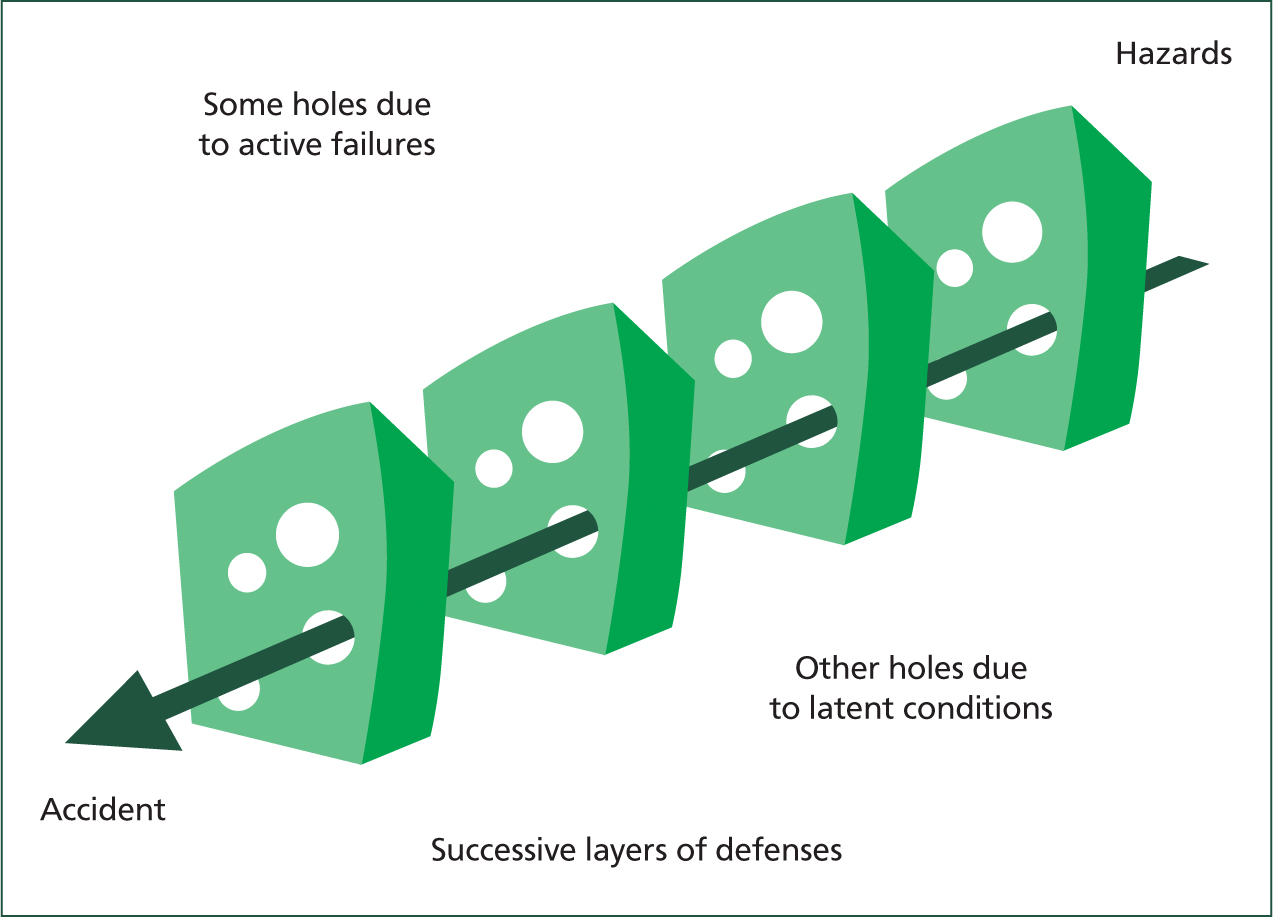
To take another hypothetical example: perhaps the veterinary surgeon would not have made a mistake with the emergency if it had turned up at 10 am instead of 7 pm — i.e. in the morning rather than in the evening, at the end of a busy shift. Perhaps the owner of this emergency would have come down sooner had they been able to get through on the phone when they first tried. Perhaps, had the receptionist not been dealing with a complicated case at the time, they would have taken the call. So really the mistake was not anyone's ‘fault,’ but the result of a set of circumstances.
So how to get started with SEA in your practice?
First of all keep a log of significant events: these do not need to be clinical, they can be anything that is significant in the care of the patient or the running of the practice (RCVS Knowledge, n.d.c). They could be serious errors, like an incorrect medication given to a patient, or moderate errors as when laboratory results go astray. Nonclinical events that impact the practice can also be discussed, as can occasions when everything goes right! A SEA can be used to celebrate successes too.
Near misses are another valuable area to discuss and examine. A near miss is any incident that may have caused harm to a patient, but fortunately did not (Patient Safety Network, 2019). Investigate these to reduce the likelihood of them recurring and progressing to an accident the next time. As with all these topics, involving the team on the ground who actually do the work part is vital. For example, a rabbit anaesthetic death might appear to be a purely clinical event, but what if the owner waited for a long period with her rabbit next to a barking dog. Depending on the scenario, the perspective of the reception team could be essential.
Positive discussions, which avoid blaming individuals after a significant event, can improve teamwork, communication and team morale too (Pringle, 2009), and so contribute to improving the whole practice culture.
The whole team should hold a meeting to analyse the incident, looking at clinical records, any other documents such as consent forms or letters of complaint from clients and most importantly the accounts of all the team members involved.
This meeting should look at what happened, why it happened, both the main reason and any underlying reasons, what has been learned and what needs to change. This needs to be carried out in a way that emphasises to all team members that it is about improving systems in the practice
Finding root causes, rather than jumping to an obvious conclusion, is a really important way of looking at significant events. This can be done in many ways including ‘the 5 Whys technique’ — not taking the first explanation but asking why at least five times to get to the core of the issue (a bit like a small child constantly repeating why !) (Institute for Health-care Improvement, n.d.). This can work for simple problems but is not suitable for more complex situations, and can be open to individual interpretation (Card, 2017). The example in Figure 4 shows how this can be used in practice.
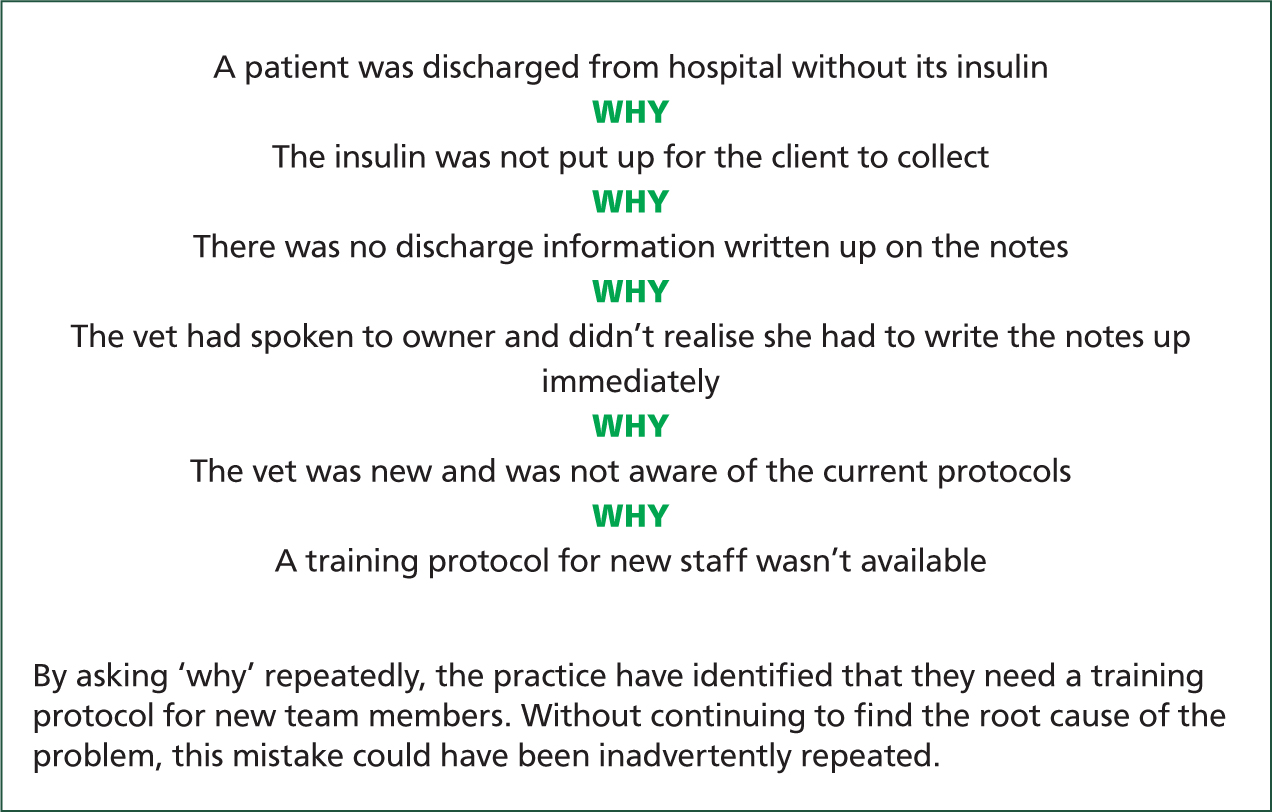
A Fishbone cause and effect diagram (also called an Ishi-kawa diagram) can be used to look more fully into all the factors involved (RCVS Knowledge, n.d.d). This is a very visual method of looking for root causes to help breakdown complex problems from different perspectives as in Figure 5.
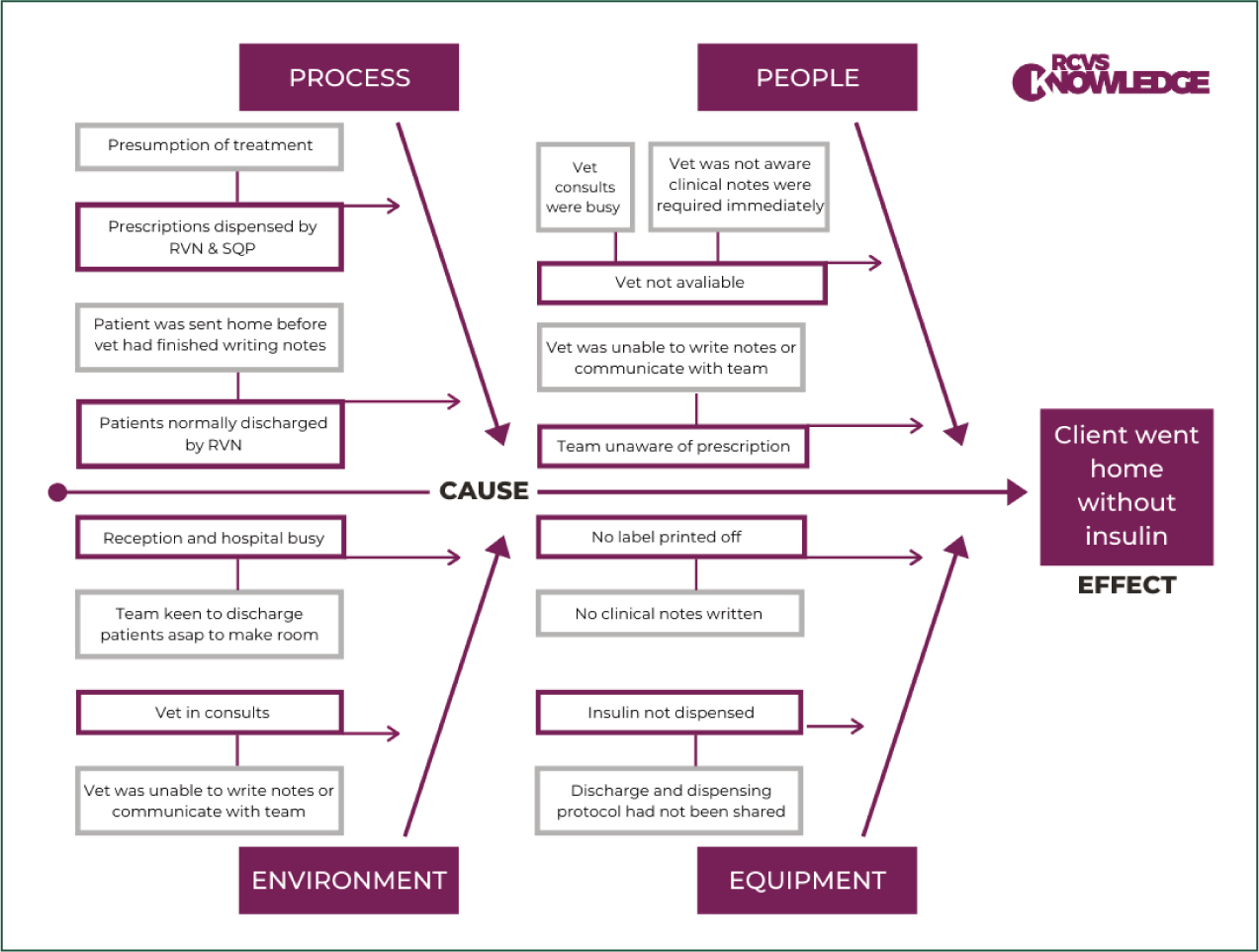
A more structured method of looking for root causes is a contributory factors checklist — this detailed list of possible underlying factors (Figure 6) is particularly useful when an event is likely to have multiple causes or involve larger organisational factors (RCVS Knowledge, n.d.).
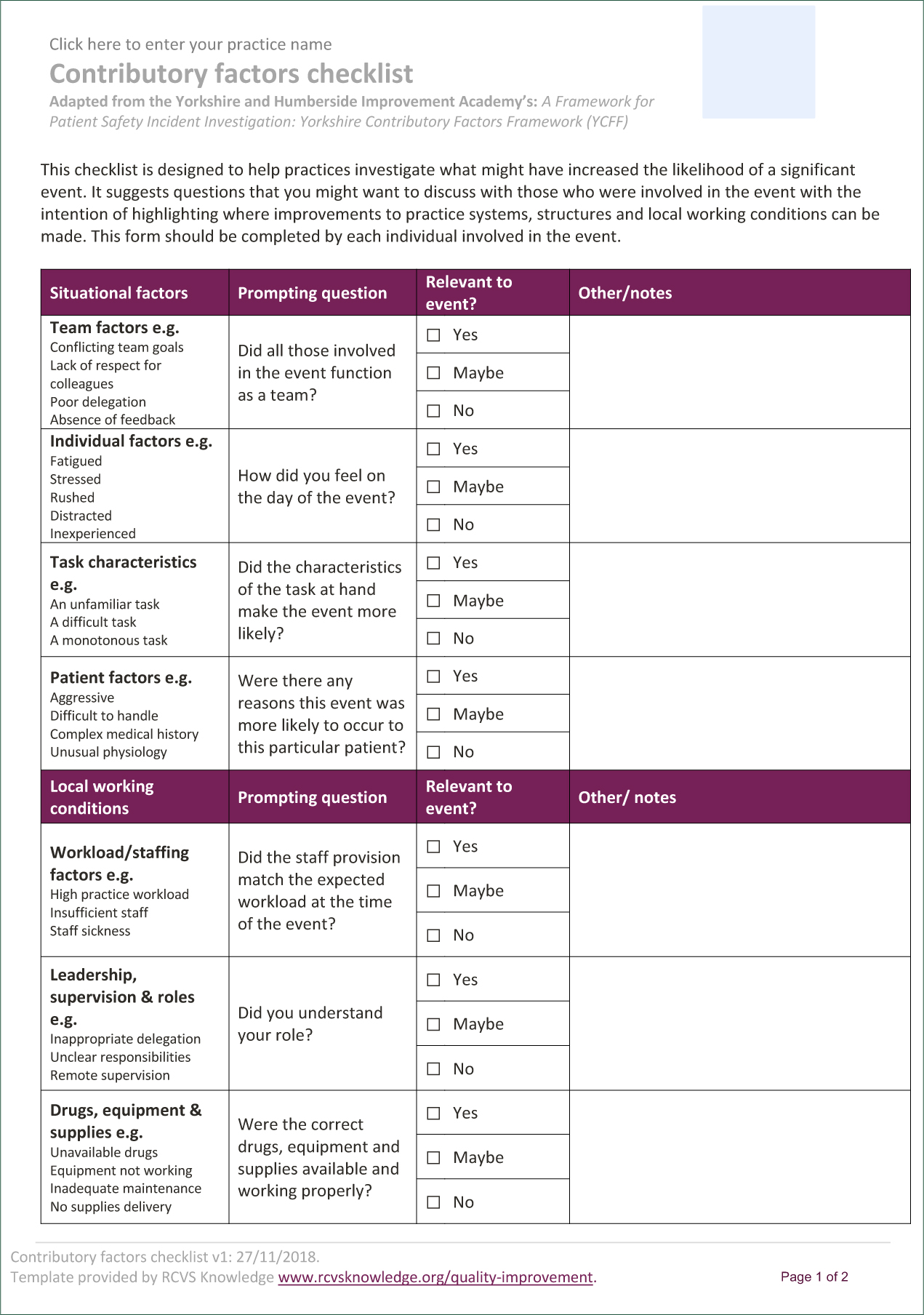
All these methods can help team members to consider all possible factors, prioritise and highlight areas for improvement. It is important that root cause analysis is followed by action to make improvements where needed.
Whichever method of root cause analysis is used it is important that the whole practice team knows what is happening and that the analysis is being used to improve systems, not blame individuals (Pringle, 2009).
Checklists
Systems of work, like checklists for surgical procedures or case handovers, can reduce the incidence of errors, protecting not only patients but also team members from the stress of dealing with complaints (McMillan, 2014). Checklists are not just a piece of paper with vital steps that may easily be missed — another benefit of checklists is that they can improve the non-technical skills of the practice team including decision making and communication (van Klei et al, 2012). There is evidence that if a team member speaks (for example by reading out the checklist) they are more likely to speak up if they notice any issues during the procedure (RCVS Knowledge, n.d.e). They encourage a culture of teamwork, assertiveness in raising issues, and can reduce hierarchies.
Conclusion
Culture can be difficult to describe in the context of veterinary services, but by referring to the medical literature we can quite quickly get a better sense of what a ‘good’ veterinary culture would look like.
Quality improvement can be seen as both a (rather mundane) administrative task and an inspiring vision. In reality, if practiced regularly, and recognised by the whole team as a worthy principal, it quickly becomes an effective methodology for improving culture too.
Teams should be given the opportunity to embrace quality improvement by:
- Measuring what they do
- Making evidence-based changes
- Using checklists and systems of work to reduce errors
- Exploring errors with a view to changing systems, instead of blaming individuals
- Having their concerns heard.
This will then produce the right conditions for a happier, safer and more productive work environment.
By encouraging clear communication (for better quality) and institutionalising learning (for better quality) our interactions with team-mates become less confused and confusing. We understand our role within a team with a greater sense of shared endeavour, and accidents become opportunities to learn instead of shameful, and shaming experiences.
Quality improvement and patient safety nourish culture by allowing staff to talk openly about their concerns and their ideas for improvement. Quality improvement and patient safety help teams work more closely together and accept that mistakes are inevitable. Quality improvement and patient safety ultimately help us see that we are all human, but as humans we are best placed to help the animal patients we care so deeply about.
KEY POINTS
- Engaging with quality improvement tools can benefit patient safety and practice culture.
- Mistakes are inevitable but a healthy practice culture will have a blame free attitude to errors.
- Significant event meetings focus on improving systems rather than blaming individuals.
- Listening to the team who do the work to understand what issues are affecting them, the patients and clients is key, and an efficient way of making relevant changes.
- Using clinical audit to measure outcomes and discussing ways to improve can contribute to a healthy practice culture.
- Checklists are a useful tool for improving communication, as well as for reducing the chance of an unintended accident.
- Quality improvement is a key element of a good veterinary workplace culture — allowing team members to talk freely about accidents, as well as their ideas.


